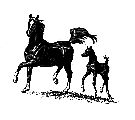Prostaglandins
PROSTAGLANDINS
Prostaglandins are widely used in horse breeding programs. Their affect on the ovary is to cause regression of the corpus luteum (CL) (see CLIENT TIP SHEET - PROGESTERONE). Once the CL digresses and no longer produces progesterone, a follicle can begin developing. As the follicle matures, it will start releasing estrogens. These hormones cause the mare to show signs of heat (sexual receptivity in the horse). The first signs are seen as early as three days after the prostaglandin injection and ovulation occurs three to five days later.
The normal length of the heat cycle is twenty one days. This is twenty one days from ovulation to ovulation, twenty one days from the first day of heat to the first day of the next heat, etc. The mare stops showing signs of heat thirty-six hours after ovulation (release of the egg from the ovary). From the last day of heat, it will be sixteen days until the first day of the next heat. An average heat lasts five days.
If a prostaglandin injection is given seven days after heat, the mare will start showing the early signs of a new heat in three days. This is six days earlier than if she was left to have a natural heat. The obvious advantage to this use is the shorted time from one heat period to the next.
Another very important use of prostaglandin is scheduling the mares' heat. This is very important when scheduling shipments of semen or scheduling visits to the breeding shed. Once prostaglandin has been administered, the stud farm can be notified of the mare's schedule with a fair degree of confidence.
If the stallion is being collected for artificial insemination or for shipping cooled semen, advance notification will assure the semen availability when there is not enough to go around. Also when shipping semen, scheduling the mare to ovulate during the week is important so semen can be shipped during the week, eliminating the need for shipping over a weekend when rates are higher if shipping is possible at all. With artificial insemination, programming the mares with prostaglandin will group them for more efficient semen use, and the stallion is collected less often.
With heavily booked stallions being bred naturally, calling early and "being listed" has gained a reservation on the breeding schedule.
Prostaglandins have therapeutic uses as well. If the mare has an accumulation of fluid, inflammatory products (pus), or post foaling products within her uterus, prostaglandin will stimulate contractions of the longitudinal muscles, which moves the contents toward the cervix. Expelling this material reduces the amount remaining that the mare's immune system must remove (the process is called uterine clearance). In some mares, uterine clearance is compromised by age, and removal is very difficult or impossible. To leave products within the uterus could cause irreparable harm to the lining and reduce the chances of rebreeding. The presence of even small amounts of fluid can interfere with both sperm transport through the uterus on the way to the oviduct and implantation by the embryo after dropping into the uterus from the oviduct. Prostaglandins, along with oxytocin and uterine lavages, help these mares improve their uterine environment.
We hope this brief description helps you understand the use of prostaglandin and why it is important in your mares' breeding program.
CLICK BELOW TO DISPLAY A PRINTER-FRIENDLY COPY OF THIS ARTICLE
Select "Open this file from its current location," if you just want to print it out,
it will open in a simple word processing application, select the print button.
(unless you want to save this article in your computer's memory)
 CTS_PROSTOGLANDINS.rtf
CTS_PROSTOGLANDINS.rtf

